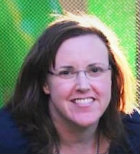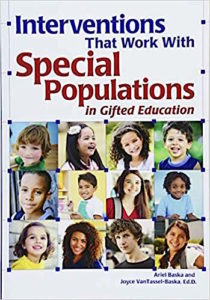Serving Gifted Students from Special Populations
Interventions That Work With Special Populations in Gifted Education
By Ariel Baska and Joyce VanTassel-Baska, Ed.D.
(Prufrock Press, 2018 – Learn more)

Interventions That Work With Special Populations in Gifted Education is a practical guide for anyone who works with students from special populations, including students living in poverty, English language learners, and twice-exceptional students.

Ariel Baska, a Latin teacher, and Dr. Joyce VanTassel-Baska, a nationally known expert in gifted education, collaborated in a case study of ten successful gifted students from special populations. These students’ stories form the basis for many of the strategies suggested in the book.
Complex case studies
The case studies of each student in Part I introduce the reader to some of the various characteristics that educators might see and look for in students from special populations. The students featured display complex profiles with combinations of challenges such as autism, hearing impairment, learning disabilities, depression, poverty, cultural differences, and English as a second language.
The case studies serve a dual purpose. Not only do they provide educators with real-life examples of how gifted students from special populations might present in the classroom, they also focus on what helped these students succeed. The strategies most commonly cited by the students as most helpful are the focus of the rest of the book.
Class and school based interventions
Both academic and affective interventions are suggested in Part II: What Interventions Work With Special Populations? The school-based interventions highlighted include acceleration in areas of strength, the importance of relationships with teachers, mentorship opportunities, and career exploration. Effective classroom-based interventions include problem-based learning, literature webs, higher level thinking, creativity, and the arts.
Sample lesson plans are provided to assist teachers in implementing these strategies in their classrooms. Part II concludes with a section on various activities that teachers can use to help meet the affective needs of gifted students from special populations.
Spotlighting school-wide support structures
The importance of having school-wide support structures is emphasized in Part III. Administrators would find this section particularly helpful, as guidance is provided about what is needed to develop support structures for special populations. In addition to school-wide support, suggestions are also made for teachers based on what the students in the case study found to be the most important characteristics of the teachers who helped them succeed.
A recurring theme in the case studies and suggested interventions is the importance of remaining flexible. The needs of gifted students from special populations are so varied and diverse, and sometimes almost contradictory, and flexibility in identification, differentiation, acceleration, scheduling, and classroom environment are all necessary to facilitate these students’ success.
Plentiful resources
The authors also provide excellent resources throughout the book. Over a dozen model lessons designed to facilitate student success can be used and adapted by classroom teachers. The appendices include tools such as a student survey and an independent study contract. There is an informative, reproducible, myth-busting guide, “Common Misconceptions About Gifted Learners With Special Needs,” that can be shared with teachers, administrators, and other key personnel. The authors provide this tool to help adults become better advocates for these students’ needs.
A key takeaway from this book is the need to identify and serve this fragile population of students for whom school can often be a barrier to success. It is crucial for general educators and administrators to understand how to best serve the needs of gifted students from special populations so that all students are given the opportunity to succeed.
Pamela Shaw (@PamShaw23) has multiple part-time jobs which allow her the flexibility to manage the ups and downs that come with parenting two twice exceptional kids. She is a substitute teacher, homebound tutor, private music teacher, virtual school teacher, and online course reviewer. She is on the board of the Chicago Gifted Community Center and has also served on the Illinois State Board of Education’s Gifted Advisory Council. Currently, she is working toward a M.Ed. with an emphasis on gifted education through the University of Missouri’s online program.






























